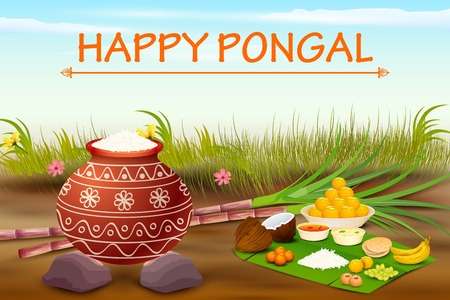
Pongal might not be a familiar word to many of us with western heritage but from a cuisine point of view, it is a very popular rice dish for Indians from southern India and Sri Lanka. It is also the name of a special Hindu festival, celebrated in mid-January and is observed in Tamil Nadu for four days. It is a thanksgiving to the sun and rain, the harvest and the farmers who bring food to our table. Many think of it as the equivalent of a harvest festival which in this case is centered on the ritual rice dishes – both sweet and sour.
Pongal food has as much significance and meaning as other Hindu festivals because of the celebration of the season’s bounty and a good harvest. The time of the festival marks the point when the sun starts travelling north (uttarayana punyakala) in the Hindu calendar.
Pongal means ‘flowing over’ and symbolises a flowing of prosperity in the home and community. In or on Pongal day which is about the 14th or 15th January, the rice is cooked in a pot facing east. The milk added to the pot overflows it and represents or symbolises great abundance which is prayed for in the following year.
Thai Pongal
Thai Pongal is the most important day of the Festival. It is the second day of the four days of festivity which is also celebrated as Sankranti. However, on the same day, Makar Sankranti is observed in North Indian states and people take a holy dip in the river Ganges. People worship the Lord Sun and offer Pongal as a Prashad to them, hence the name of the festival.
Pongal Cuisine – The Rice Dishes
Pongal is also a popular rice dish served at breakfast time in Tamil Nadu, Sri Lanka (generally), Telangana and Andhra Pradesh. There are two varieties, Chakkara Pongal which is a sweet made of rice boiled with milk and jaggery, coconut bits or mung beans, and is produced during the Pongal festival. One other feature of this dish – it is made in special earthenware pots with a wood fire.
Another type is Venn or Ven Pongal which is made from clarified butter. Venn is the old Tamil word for white. The spicy type contains mainly rice flavoured with pepper or tamarind. It is a popular dish. It is typically served as a special breakfast in parts of Sri Lanka (Northern and Eastern Sri Lanka), South India, especially Tamil Nadu, Telangana and Andhra Pradesh.
Tamil References
In Tamil the root “pongal” or in Telugu “pongu” means to ” boil over” or “spill over”. In Kannada it is called Huggi (ಹುಗ್ಗಿ).The origin of the dish is claimed to be Jaffna in Sri Lanka but also Tamil Nadu in India. There are other variants called melagu pongal and puli pongal.
Chakkara pongal
Chakkara pongal (literally sweet pongal) is generally prepared in temples as a prasadam, (an offering made to a deity). This dish is also made during Pongal / Sankranti in Jaffna, Sri Lanka,Tamil Nadu, Telangana and Andhra Pradesh, India.
Ingredients can include rice, coconut and mung bean which are common ingredients. Some rice dishes in this genre also have dried fruits added to them. Sakarai pongal is traditionally sweetened with jaggery, which gives the rice dish a characteristic caramelised brown colour, though it can be sweetened with white sugar instead.
Melagu pongal
Melagu is a spicy variant made with pepper, rice and moong daal. A classic recipe is the following taken from my friend’s mother’s own cookbook:-
Ingredients:
Serving size: 4
- 1 glass white rice
- 1/2 glass moong dal
- 2 spoons black pepper
- 2 spoons jeera
- 5 tablespoons ghee
- cashew nuts to taste
- A pinch of ginger powder
- A pinch curry leaves
Preparation:
Preparation time: 15 – 20 minutes Cooking time: 30 minutes
- Fry the moong dal and the rice together in a frying pan laced with some oil for 3 minutes.
- Add 3 cups of water in a pressure cooker and add the rice and moong dal. Cook for it all for between 5 to 6 whistles or according to the manufacturer’s instructions
- Blend a powder together of pepper and jeera.
- To a frying pan, add the ghee. After the ghee is gently frying, add the pepper and jeera mix, some cashews, ginger and curry leaves.
- After 6 whistles open the cooker, and add the frying pan’s contents into the cooker. Stir well and add ghee if necessary. Serve hot with chutney or sambar.
Puli pongal
Puli is a variant that is made with tamarind and boiled rice. It is not specifically associated with the Pongal festival and is often eaten for dinner.
As a final word, it is worth trying a tomato pachadi with this because there is a nice combination of flavours there. You apparently can also make it with quinoa instead of rice.
References
South Asian Religions: Tradition And Today. (2013) edt. Karen Pechilis, Selva J. Raj. Routledge. London & New York

Good. take a look at http://www.pongalnyc.com/
I tried this recipe and it was great. I am from Kerala so have been following your web-site for some years because of the Indian recipes. I think you might be a secret Indian or something! The recipe I think is good too with sona masoori rice. I like that you dont have adverts either – they are really beginning to irk me on other cooking sites.